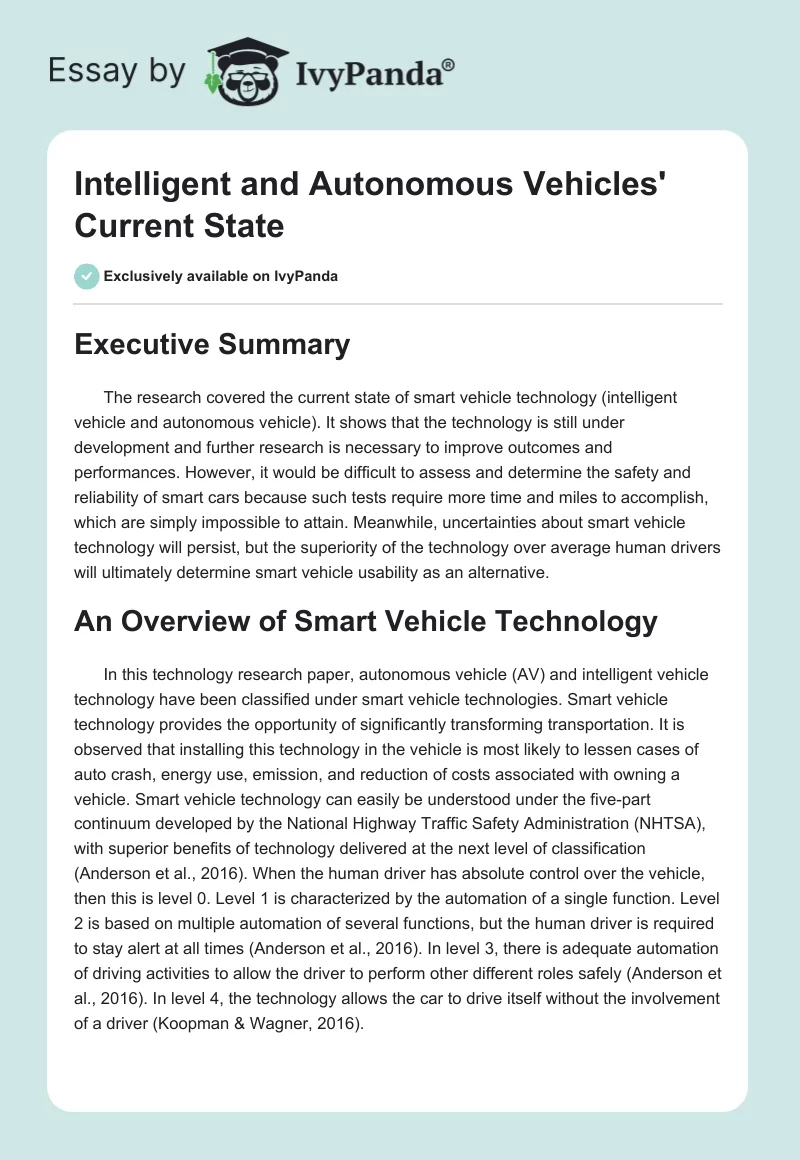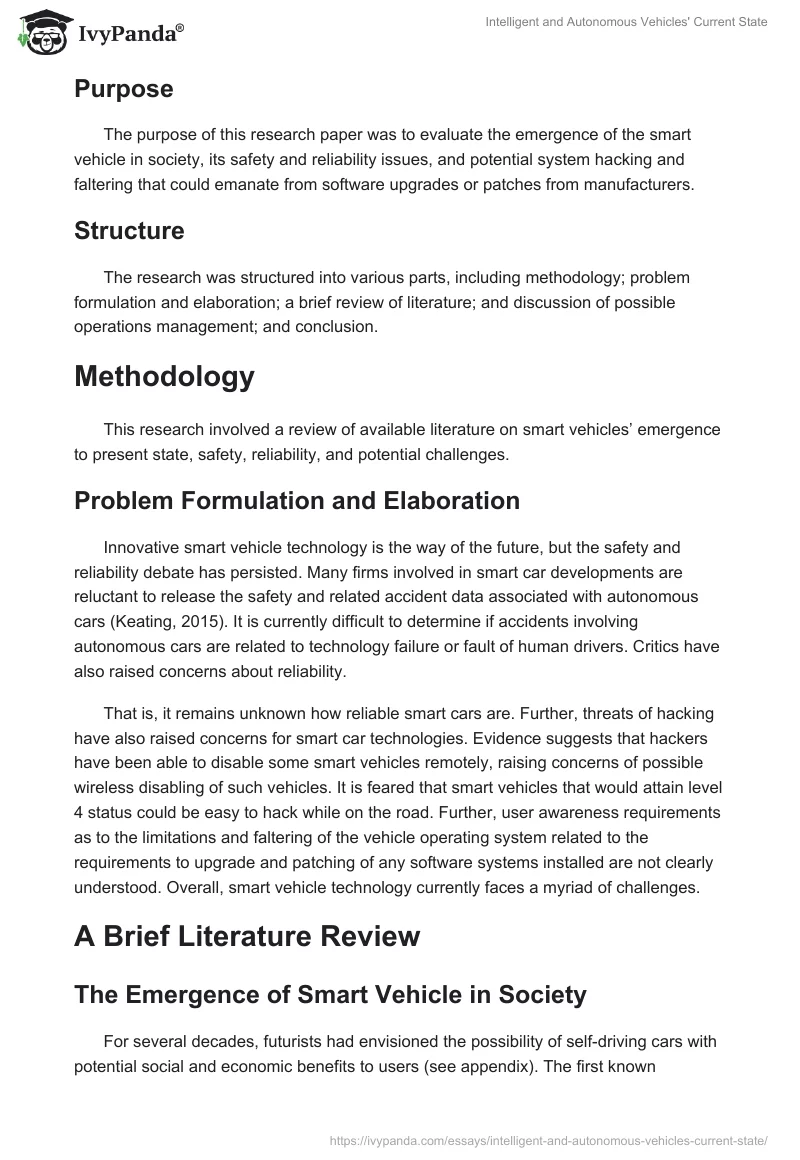Executive Summary
The research covered the current state of smart vehicle technology (intelligent vehicle and autonomous vehicle). It shows that the technology is still under development and further research is necessary to improve outcomes and performances. However, it would be difficult to assess and determine the safety and reliability of smart cars because such tests require more time and miles to accomplish, which are simply impossible to attain. Meanwhile, uncertainties about smart vehicle technology will persist, but the superiority of the technology over average human drivers will ultimately determine smart vehicle usability as an alternative.
An Overview of Smart Vehicle Technology
In this technology research paper, autonomous vehicle (AV) and intelligent vehicle technology have been classified under smart vehicle technologies. Smart vehicle technology provides the opportunity of significantly transforming transportation. It is observed that installing this technology in the vehicle is most likely to lessen cases of auto crash, energy use, emission, and reduction of costs associated with owning a vehicle. Smart vehicle technology can easily be understood under the five-part continuum developed by the National Highway Traffic Safety Administration (NHTSA), with superior benefits of technology delivered at the next level of classification (Anderson et al., 2016). When the human driver has absolute control over the vehicle, then this is level 0. Level 1 is characterized by the automation of a single function. Level 2 is based on multiple automation of several functions, but the human driver is required to stay alert at all times (Anderson et al., 2016). In level 3, there is adequate automation of driving activities to allow the driver to perform other different roles safely (Anderson et al., 2016). In level 4, the technology allows the car to drive itself without the involvement of a driver (Koopman & Wagner, 2016).
Purpose
The purpose of this research paper was to evaluate the emergence of the smart vehicle in society, its safety and reliability issues, and potential system hacking and faltering that could emanate from software upgrades or patches from manufacturers.
Structure
The research was structured into various parts, including methodology; problem formulation and elaboration; a brief review of literature; and discussion of possible operations management; and conclusion.
Methodology
This research involved a review of available literature on smart vehicles’ emergence to present state, safety, reliability, and potential challenges.
Problem Formulation and Elaboration
Innovative smart vehicle technology is the way of the future, but the safety and reliability debate has persisted. Many firms involved in smart car developments are reluctant to release the safety and related accident data associated with autonomous cars (Keating, 2015). It is currently difficult to determine if accidents involving autonomous cars are related to technology failure or fault of human drivers. Critics have also raised concerns about reliability.
That is, it remains unknown how reliable smart cars are. Further, threats of hacking have also raised concerns for smart car technologies. Evidence suggests that hackers have been able to disable some smart vehicles remotely, raising concerns of possible wireless disabling of such vehicles. It is feared that smart vehicles that would attain level 4 status could be easy to hack while on the road. Further, user awareness requirements as to the limitations and faltering of the vehicle operating system related to the requirements to upgrade and patching of any software systems installed are not clearly understood. Overall, smart vehicle technology currently faces a myriad of challenges.
A Brief Literature Review
The Emergence of Smart Vehicle in Society
For several decades, futurists had envisioned the possibility of self-driving cars with potential social and economic benefits to users (see appendix). The first known attempts to build autonomous cars started in Japan in 1977 (Forrest & Konca, 2007). However, recent research has focused on the periods between 1980 and 2003 to demonstrate the developments of vehicle automation, which referred to highway automation or special roads for ‘dumb vehicles’ and the other development focused on smart vehicles using normal roads (Anderson et al., 2016). Between 2003 and 2007, the U.S. Defense Advanced Research Projects Agency (DARPA) advanced research in smart vehicle technologies.
The more recent developments are characterized by the involvement of traditional auto manufacturers and Silicon Valley technology giants. Google has developed and tested an autonomous, driverless car to demonstrate the actual application of the smart vehicle technology (Anderson et al., 2016). Uber also has joined the trend. Between 2013 to present times, other manufacturers, such as Audi, and Toyota now focus on developing such autonomous cars. Meanwhile, Ford Smart Mobility will launch the self-driving car in 2021 while Nissan has a plan to sell smart vehicles by 2020. Smart vehicles are expected to reduce road congestion and save lives by eliminating accidents related to human errors.
Current State of Smart Technology
Google has tested its autonomous cars over 500,000 miles with no crashes related to the automation, although accidents have been reported (Anderson et al., 2016; Keating, 2015). Smart vehicles are fitted with advanced sensors that collect information about their environment, and they rely on increasingly complex algorithms to analyze sensor data and control the car. Computational capabilities are utilized to run these features in real-time.
The technology is based on the model of ‘sense-plan-act’. Various systems are deployed (sensors, laser illuminating detection, and ranging (LIDAR), radar, high-powered cameras, and learning algorithm software) to complement and counteract weaknesses from other systems (Keating, 2015). It is perhaps making sense of the collected data that remains the major obstacle in delivering ultra-reliable autonomous vehicles. For localization, smart vehicles rely on the Global Positioning System (GPS) and inertial navigation systems (INS) (see appendix), but the challenge of somewhat inaccurate occurrences persists.
Smart vehicles currently require back-up systems to ensure that any adverse effects of failure can be quickly mitigated. However, such back-up systems may be difficult to develop. Attaining this level of reliability is difficult, but ‘shared driving’ between autonomous cars and humans is considered. For safety, however, it could be nearly impossible for human drivers to abandon other tasks and engage the vehicle in a matter of seconds to avert potential catastrophes (Wright, 2016). Besides, communications between vehicle to vehicle and vehicle to infrastructure are not clearly defined. Safety and software update issues also hinder the development of autonomous vehicles. Legal requirements for smart vehicles to operate on the road are not available. Hence, the lack of legal provisions currently hinders the development of this technology (Keating, 2015).
Safety and Reliability
Evidence suggests that it could be difficult to determine safety and reliability of smart vehicles until they are driven for over “hundreds of millions of miles and sometimes hundreds of billions of miles to demonstrate their reliability in terms of fatalities and injuries” (Kalra & Paddock, 2016, p. 10), which would take hundreds of years to drive. Hence, this is an impossible task to accomplish if the goal is to determine the performance of these cars before they are allowed for public use and, thus, uncertainty will always persist.
Management, Measures, and Techniques Relevant to the Topic
The most vital aspects of management, measures, and techniques related to smart car technology performance. Hence, vehicle safety, reliability, protection from hacking, and software upgrade remain major performance indicators.
Approach Methodology/Presentation/Body of Discussion
It is generally acknowledged that smart vehicle technology will dominate the future. However, the current state of technology and available evidence suggest that autonomous vehicle developers and testers cannot address safety and reliability concerns immediately (Kalra & Paddock, 2016). The technology still grapples with a software upgrade, safety, reliability, and legal requirements among others. Results suggest the requirement for substitute ways to enhance technologies and support actual applications during testing for formulating sound laws. Further, the technology should evolve to support smart vehicles. Hence, software upgrades, safety, reliability issues remain primary concerns for potential users and other road users. Overall, it is observed that a more systematic strategy than a simple cycle of “system-level test-fail-patch-test will be required to deploy safe autonomous vehicles at scale” (Kalra & Paddock, 2016, p. 1).
Conclusions
A smart vehicle is touted as the future of driving. However, the current state of technology does not allow the safety and reliability of such cars to be determined. The technology is now defined by persistent uncertainties. Nevertheless, further research is most likely to improve outcomes and assist in better comprehension of inherent uncertainties. Software testing and deployment will have to be improved while protecting cars from hacking threats. Additionally, policymakers will have to formulate regulations and laws that support smart vehicle technology to advance its social welfare benefits to users. Once the smart vehicle technology has demonstrated superior performance than average human drivers, then self-driving cars should be permitted.
References
Anderson, J. M., Kalra, N., Stanley, K. D., Sorensen, P., Samaras, C., & Oluwatola, O. A. (2016). Autonomous vehicle technology: A guide for policymakers. Santa Monica, CA: RAND Corporation.
Forrest, A., & Konca, M. (2007). Autonomous cars and society. Web.
Kalra, N., & Paddock, S. M. (2016). Driving to Safety. Santa Monica, CA: RAND Corporation.
Keating, L. (2015). The driverless car debate: How safe are autonomous vehicles? Web.
Koopman, P., & Wagner, M. (2016). Challenges in autonomous vehicle testing and validation. Web.
Wright, E. (2016). The legal challenges for autonomous vehicles. Web.


